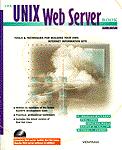

This book is well-written and informative, fills a gap in available books, and its authors bear impeccable credentials.

Author: R. Douglas Matthews, Paul Jones, Jonathan Magid, Donald A. Ball, Jr., Michael J. Hammel
Publisher: Ventana Communications Group, Inc.
http://www.vmedia.com
ISBN: 1-56604-480-4
Price: $49.99US
Reviewer: Gerald Graef
The most overly published book today is the WWW book. How to, Where to, Why to. It's all available in repetitious detail. Only a few aspects of the Web aren't overdone. Server administration is a big one (a WWW book catalog is another). A good book with background and information on the various choices of server software would be a boon. Such a book is The Unix Web Server Book by R. Douglas Matthews, Paul Jones, Jonathan Magid, Donald A. Ball and Michael J. Hammel. It is well-written and informative, fills a gap in available books, and its authors bear impeccable credentials.
Setting up a web server is not a difficult task (given a stable Internet site), but it is one that requires a unique set of tools. The Unix Web Server Book was written to allow someone with little or no experience with the Web to set up a server. This is perhaps something of an anomaly, since anyone capable of administering a Unix system is likely to have enough basic knowledge to configure a web server using software documentation. Still, there is a necessary background that this book attempts to fill.
The Unix Web Server Book assumes no prior knowledge of the World Wide Web and so begins with a brief history. Chapter two, “The Basic Pieces”, is summed up by the chapter legend “What is this http:// stuff?”. Chapter three compares servers and recommends Apache, a freeware server available for many platforms. An introduction to web security follows. In the next ten chapters, introductions are given to the elements of developing web pages, including HTML, importing documents, images, multimedia, searching, forms, advanced CGI, Java and HTML checkers. Finally, “Fitting in: Joining the Virtual Community” finishes up the book. It's all at a pretty basic level, but the sum is a hefty book with voluminous references to on-line resources.
Included with the book is a CD-ROM containing many of the tools and programs necessary to get a web server up and running, including the Red Hat Linux distribution, Apache web server, HTML utilities, graphics programs, CGI packages and more, all arranged by chapter of discussion. The collection makes an excellent beginning to a web site (“beginning” since no true webhead is ever content).
When I received a copy of the book, I was hopeful of an easy installation of the latest version of Red Hat Linux. Unfortunately, the version included is not supported by either Red Hat Inc. or the publisher of this book. Moreover, the CD-ROM directory structure is incorrect; although the distribution is complete, the install program expects a specific directory structure that is not adhered to on the CD-ROM. It is possible to copy the files onto a hard disk (about 300MB total) and install. However, a better option is to splurge and buy the latest version of a Linux distribution. This has the added benefit that many of the CD-ROMs available contain software useful for web sites.
The Unix Web Server Book is a solid guide for someone new to the Web who is charged with developing not only a web site, but also a web server. More advanced readers may find the book too basic and may often be frustrated at the tantalizing hints of deeper truths. Fortunately, the book is a gold mine of annotations to web resources for everything covered—right back to Vannevar Bush's ground- breaking 1945 article “As We May Think” on the electronic linking of documents. Future server administrators may find this book useful depending on their network experience. More likely, they'll gain more from a book that is dedicated to whatever task is at hand. Finally, one group who will find this book of interest is the experienced web surfers looking to understand how the Web works, but who aren't actually going to set up a server. And don't overlook that CD-ROM—if you don't have fast access to the Internet, having all the basic web software at your fingertips is very nice indeed.